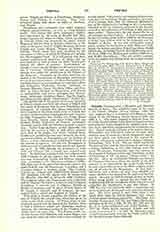

Tripolis (TRIPOLITANA), a Maronite and Melchite diocese, in Syria. The primitive name of the town is not known; Dhorme (Revue biblique, 1908, 508 sqq.) suggests that it is identical with Shi-ga-ta mentioned in the El-Amarna letters between 1385 and 1368 B.C. The name Tripolis is derived from the fact that the city formed three districts separated from each other by walls, inhabited by colonists from Aradus, Tyre, and Sidon, and governed by a common senate. Almost nothing is known of its ancient history. Christianity was introduced there at an early date; mention may be made of a much frequented sanctuary there which was dedicated to the martyr St. Leontius, whose feast is observed on June 18 (Analecta bollandiana, XIX, 9-12). The see, which was in the Province of Tyre and the Patriarchate of Antioch, had a bishop, Helladicus, in 325; other bishops were: the Arian Theodosius; Commodus, who was present at the Council of Ephesus in 431; and Theodorus, at that of Chalcedon in 451 (Le Quien, “Oriens christ.”, II, 821-24). After an earthquake Tripolis was restored by Emperor Marcianus about the middle of the fifth century, to be captured by the Arabs in 638, when it became a powerful center of the Shiite religion, resisting all attacks by the Byzantines. It then had a university and a library of more than 100,000 volumes; the latter was burned on the arrival of the Crusaders. As early as 1103 Raymond, Count of Saint-Gilles, being unable to capture the city, built on a neighboring hill the stronghold which still exists and compelled the inhabitants to pay him tribute. In 1109 the city was captured, made a countship, and given to Bertrand, Raymond’s son, and to his descendants. The latter owned it until 1289, when it was taken from them by Sultan Qalaoun, who massacred the entire Christian population. Du Cange (Les families d’outre-mer, 811-13) and Eubel (Hierarchia catholica medii nevi, I, 526; II, 281; III, 339) give the list of its Latin residential and titular bishops. In 1517 the Turks finally captured Tripoli and still retain possession of it. In 1697 the Maronite prince Youiies was martyred there for the Faith, and in 1711 the Sheikh Canaan-Daher-Shhedid.
Tripolis is now a sanjak of the vilayet of Beirut, and contains two towns linked by a tramway: El-Mina, or maritime Tripolis, on the site of the ancient city, and Taraboulos, built since 1289, at the foot of Raymond’s fortress. The two cities together contain 37,000 inhabitants, of whom 110 are Latins, 2200 Oriental Catholics of various rites, and 4000 schismatic Melchites; the remainder are Mussulmans. The Maronite bishop, Msgr. Antoine Arida, consecrated on June 18, 1908, resides at Karrusadde. The Melchite bishop, Msgr. Joseph Doumani, was consecrated on March 21, 1897. The Franciscans have the Latin parish and two establishments. In this parish are also established the Lazarists, the Carmelites, the Brothers of the Christian Schools, and the Sisters of Charity. The sanctuary of the Blessed Virgin is called Saidyat el-Harah, Our Lady of the Quarter. The Maronite diocese has 48,000 faithful, 350 priests, and 70 churches. The Melchite diocese, created in 1897, has 1225 faithful, 14 priests, 10 churches or chapels, and 6 schools. The schismatic Melchite diocese has 50,000 members.
S. VAILHE.

